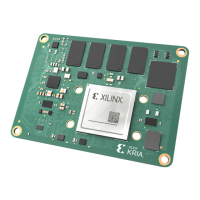SOM MIO Design Considerations
The Zynq UltraScale+ MPSoC on the SOM has a set of integrated, built-in interface IPs. These interface IPs are made available to
external pins through mulplexed I/O (MIO) selecon, which can be selected and customized for a carrier card design. The MIO
interface conguraon is set as part of the Vivado design project through the Vivado processor conguraon wizard (PCW).
The design of the SOM carrier card must give special consideraon to the MIO pins to ensure that the desired MIO peripherals are
mappable to the physical pins dened by the electrical design of the carrier card. The SOM xes the mapping of MIO bank 500 for
SOM based peripherals and a subset of bank 501 for SOM power management signals. The remaining MIO pins are congurable for
exibility in the carrier card design. The full MIO peripheral IP mapping to physical pin mapping is dened in the MIO Interfaces table in
Zynq UltraScale+ Device Technical Reference Manual (UG1085).
MIO Bank 500
The SOM xed MIO conguraons for bank 500 are outlined in the following table. This MIO conguraon is dened by the physical
SOM design and cannot be modied by carrier-card designers. It denes the MIO conguraon for the SOM peripherals: QSPI, TPM
SPI, LEDs, eMCC, and I2C conguraon bus.
Bank
500
MIO # 0 1 2 3 4 5 6 7 8 9 10 11 12 13 14 15 16 17 18 19 20 21 22 23 24 25
Peripheral QSPI SPI1 GPIO0 SPI1 GPIO0 eMMC (SD0) GPIO0 I2C1
Pin Fct sclk_out miso_mo1 mo2 mo3 mosi_mi0 n_ss_out sclk_out LED0 LED1 n_ss_out miso mosi FW_Upd data[0] data[1] data[2] data[3] data[4] data[5] data[6] data[7] cmd_out clk_out eMMC_Rst scl sda
MIO Bank 500 – Extensible I2C Bus
This MIO conguraon must be considered xed and will be pre-populated in the corresponding SOM Vivado board les. In SOM
bank 500, predened conguraon of the PS I2C interface is made available to the carrier card via the I2C_SCK and I2C_SDA signals
on the som_240_1 connector. If the carrier card does not need to extend this I2C bus, the carrier card should leave them as no
connects. If the carrier card design extends this bus, they need to ensure they do not introduce an address conict with the I2C
devices on the SOM. The I2C devices are dened in the corresponding table of the Kria K26 SOM Data Sheet (DS987).
Chapter 2: Electrical Design Considerations
UG1091 (v1.0) April 20, 2021 www.xilinx.com
Carrier Card Design for Kria SOM 32

